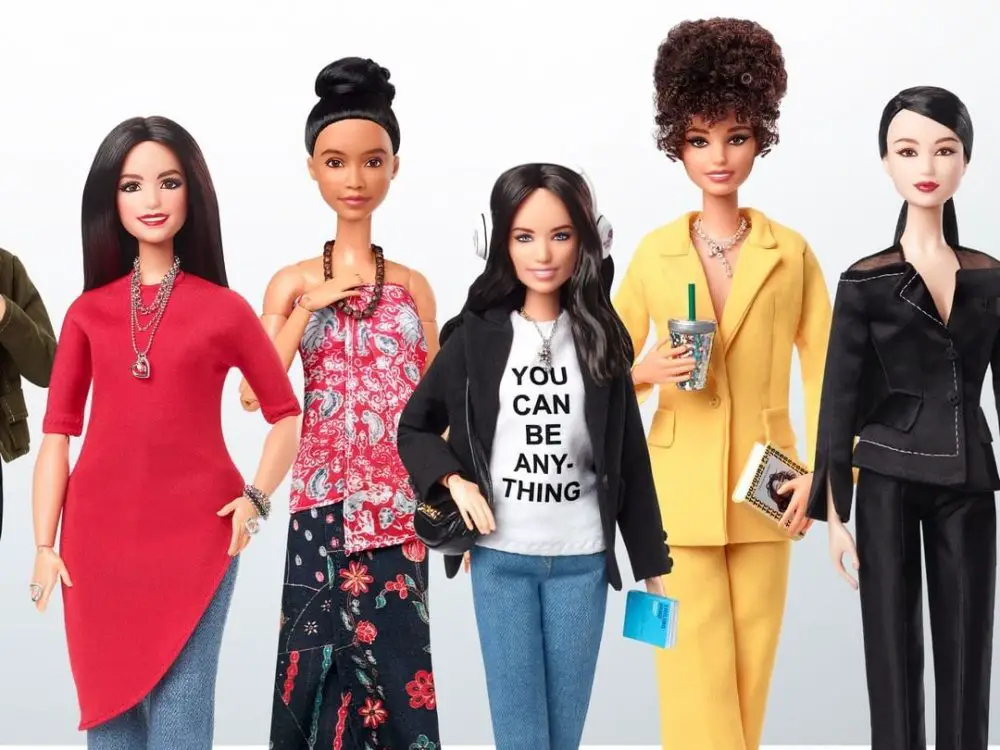“I’m a Barbie girl, in a Barbie world,” squeals Aqua at the start of their iconic hit “Barbie Girl.” Regardless if you agree with this song’s lyrics, or prefer a more “Not Your Barbie Girl” take on it, the phrase “Barbie girl” immediately brings to mind characteristics of the iconic doll. Dressed in the most stylish outfits and adorned with shiny blonde locks, Barbie’s noteworthy look has been in vogue for decades.
The Barbie doll is undoubtedly “the world’s most popular toy brand” in terms of her sought-out presence during playtime. Even though that picture-perfect image of Barbie is what pushed her into the spotlight and the shopping cart, there’s more than meets the eye when it comes to her symbol. The cultural impact of Barbie dolls in the fashion world is one thing, but her work to shift the grounds of educational “play” shouldn’t be glossed over. Barbie’s various careers across STEM, entertainment and even art all add her own personal, pink sparkle to every field she touches. To add to this catalog of success, life in the Barbie Dreamhouse just got bigger with a new addition to the doll line.
In March 2022, Mattel announced its newest addition to the Barbie Role Models doll line. The 12 brand new Barbie Role Models broke out into the public in honor of International Women’s Day, celebrating a handful of bright women leaders that made strides in their respective fields. Among the collection are well-known women of the beauty and entertainment industries, along with some stellar women in STEM who get to bask in the doll-shaped spotlight.
While the Role Models project is not new to the Barbie brand, these Global Female Role Models spice up the lineup with a global touch. Besides famous American names like Shonda Rhimes, international names such as Doani Emanuela Bertan from Brazil and Tijen Onaran from Germany take their place among this batch of icons. With the variety of fields and interests that these role models reflect, Barbie hopes to “inspire the next generation of female leaders” in the children who pick up each toy.
Prior to International Women’s Day, Barbie’s announcement received a round of enthusiastic responses on the web. Tweets from female-forward initiatives, such as Girls Who Code, led the pack with a round of applause emojis. Shortly behind, multiple Barbie fans were pleasantly surprised with the news as well. As one fan commented below Barbie’s tweet honoring the 12 new dolls, “It is about time! All girls need to be represented. Thank you.” The range of celebrations, from the large corporation to the fan-at-home, shows how impactful Barbie’s image is to girls of all ages. No matter who ends up buying the dolls or playing with them, the vast array of fans who feel inspired by the newest line of toys shows a positive reception to Mattel’s intentions.
Each debuted Role Models doll contributes to The Dream Gap Project run by the Mattel company. The term “dream gap” refers to the presumed notion that everything associated with girls — their work, efforts and abilities — are given lesser value than what boys produce. Unfortunately, the results of these assumptions lead to low self-esteem in young girls, and the belief that they cannot reach the goals they’ve dreamt up. While ongoing waves of feminism aim to combat these complexities on a sociopolitical level, how does one change this hindering mindset from an early age? Enter Mattel’s The Dream Gap Project. The timeless Barbie image combines with the need to close that “dream gap,” which motivates a new set of intentional dolls and toys.
At the heart of the project, the campaign “gives girls the resources and support they need to continue believing in themselves.” With dolls like the Role Models line, presenting female success in the physical form of ownable dolls helps enact that long-awaited change. Since 2018, Barbie has used its line of “Role Models” to uplift successful women that tend to be overshadowed. Consider the female leaders in STEM or entrepreneurial careers, whose markers of success do not often fit the box of “popular” mainstream media: These women rarely get the recognition they deserve for all the milestones that they’ve reached. Barbie Role Models and The Dream Gap Project want to use toys as a gateway to change the way we talk about women leaders, while also adopting a new way to think about playtime.
But what about the faces behind Barbie’s newest Role Models? Who are these wonderful women who’ve captured the doll-sized hearts of Barbie fans? These dolls are not just pretty princesses to play with; each of the Role Models breaks more “traditional” assumptions of dolls since they are replicated after current, thriving women. For starters, one of the notable names that have quickly gained traction was that of Shonda Rhimes. Known for the ever-popular “Grey’s Anatomy” series, which is part of the Shondaland television production company that she founded herself, the producer has been honored with a colorful depiction.
Rhimes’ Barbie dons a rainbow dress, a direct replica of her Variety magazine cover as the highest-paid showrunner on television. Variety quoted from their former cover star on how excited she was for her doll to join the ranks of other toys that “give you the ability to imagine yourself in a different world, in a different way, in a way that maybe you only secretly dreamed, or thought was impossible in real life.”
Across the pond, makeup artist extraordinaire Pat McGrath was also recreated in Barbie form. The founder of Pat McGrath Labs, as well as the first makeup artist to receive Damehood by Queen Elizabeth II, McGrath is a pillar of the luxury beauty industry. In US Magazine’s coverage of the artist’s reaction to her doll, McGrath remarked, “I would be so happy if it in any way inspires anyone to follow their dreams and believe that with hard work, creativity and perseverance, everything is possible.” Both Rhimes and McGrath are not only depicted as fashion-forward, but they also represent amazing Black women who are carving a name for themselves in their fields. Hearing these famous voices pinpoint the importance of a different kind of Barbie to play with reveals how powerful these dolls are beyond their plastic poses.
Besides the famous names that get to enjoy a Barbie status, what makes this Barbie Role Models line for 2022 extremely crucial are the names that are less familiar to the public mind. Take Doani Emanuela Bertan, for example. Many people who do not follow her field would not know she is a teacher in Brazil, specifically for students with attention deficiencies or deafness. According to Mattel, Bertan teaches in Portuguese and Brazilian Sign Language, while making accessible videos for her students to digest. Regardless of how brief this description of Bertan is, these insights are the ones that granted her Barbie Role Models status, while opening the door to new fans.
The same thing happened with a slew of other non-American names of the American-centric Barbie brand. Tijen Onaran, a famous voice of German media, may not be as prominent to Barbie’s American audiences. However, she is a sensational leader when it comes to introducing companies to diversity, inclusion and equality campaigns. As an entrepreneur — and now miniaturized Barbie doll — Onaran’s continued goal is to use her company, Global Digital Women, to inspire other businesses to adopt an inclusive mindset. Though a speedy elevator speech on Mattel’s part cannot speak volumes to what either of these women has done, it can spark curiosity for where women can triumph in the working world.
The Role Models line marks a new frontier for the Barbie name, one that is more inclusive than the singular toy dreamt up by Ruth and Elliot Handler, the co-founders of the Mattel company. Named after Handler’s daughter, Barbara Millicent Roberts — “Barbie” for short — the female figurine would carry and drop the weight of gendered norms throughout the changing decades. Whether it was for her slim, idealized femininity or the lack of POC friends by her side, Barbie was a constant source of criticism from the start.
However, no one can take away Barbie’s staunch commitment to being “a model for financial self-sufficiency” among women. Barbie never belonged to one occupation: She belonged to them all. One day she is a vet, the next she is a world-class ballerina, and on the weekends she’s off in space mapping the stars. While Barbie has been a symbol of the “working woman’s” capabilities, the need to diversify her looks comes into play for a 21st-century audience.
Though looks aren’t the dealbreaker for the Barbie toy, the act of “seeing oneself” in everyday fiction connects with how one sees themselves in real life. Who understands this better than the kids who choose to pick Barbie dolls out of the toy chest? As a marker of playtime, especially for young girls, Barbie dolls represent a powerful “mirror” of what they could be in the future. With career accessories to “change” Barbie’s occupation at a given moment, playing and telling stories with the dolls speaks to greater concerns on their own abilities. But not all kids who want to play with Barbie look like her. So where does one go from there?
The answer lies with projects like the Barbie Role Models. A dual combination of a beautiful doll reflecting powerful female leaders of the 21st-century fosters deeper, more intrinsic meanings behind the plastic toy. This doll line stands as a true reflection of what leaders look like: Through playing with the dolls, girls get to imagine achieving their wildest dreams, with the comfort that there are women who have reached similar heights of success.
The Barbie Role Models line and The Dream Gap Project grab the attention of every girl, rather than a select few, to encourage everyone to dream a little bigger each day. And the dreams don’t stop with young girls: With a movement as inclusive as The Dream Gap Project, even young boys everywhere are encouraged to look up to the women leaders around them. Nobody could have predicted that sentiment would come out of an 11-inch plastic doll from 1959.
From a cultural perspective, there’s no toy that has made as long-lasting of an impact as the Barbie doll. When new toys phase in and out of the picture with each passing year, no one mourns those quick losses. But what Barbie brings to the playtime hour is her longevity. With such a rich history behind the highs and lows that brought her to households today, Barbie has truly found ways to witness and grow alongside each new generation of children. The Barbie Role Models for 2022 is just the newest iteration of using playtime to foster children who are socially and empathetically equipped for tomorrow. In that respect, Barbie dolls are and will continue to be, everything more than just plastic playthings.

















